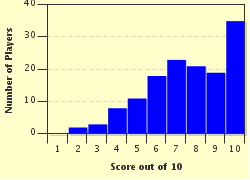Quiz Answer Key and Fun Facts
1. The Comoro islands are located in the Mozambique Channel, off the coast of Africa. This channel is a region of what ocean?
2. Which of these is NOT one of the three official languages of the Comoros?
3. What is the significance of the four stars on the Comorian flag?
4. Which of the four main islands of the Union of Comoros is also claimed by France as one of its overseas territories?
5. Since independence was first starting to be negotiated in 1963, the country we now know as the Union of the Comoros has had a number of different flags. All of them (such as this, the national flag 1992-1996) have included a star-and-crescent image, a symbol of which religion (which is the dominant religion of the country)?
6. The Comorian economy is heavily dependent on agriculture, with 80% of its workers employed in that sector. Spices form nearly half of the country's export income. The flowers of Cananga odorata produce one of its most notable export products. What is the name for the essential oil, commonly used in perfumes and scented candles, which is distilled from its flowers?
7. According to local legends, a jinni dropped a jewel into the ocean, creating a maelstrom that developed into the volcano whose eruptions produced the island of Ngazidja (Grande Comore). What is the name of this still-active volcano, whose peak is the highest point in the country?
8. The Comoros has a large number of endemic species (animals and plants that are only found there), including Pteropus livingstonii, illustrated here. What is this mammal's claim to fame?
9. Increasing international pressure on the Comoros to protect their delicate environment led to the establishment of the nation's first protected area. On which island was this marine park officially established in April, 2001?
10. The musical tradition of twabar music, imported from Zanzibar and adapted locally, features a number of instruments which are not widely seen in the European musical tradition. What is the name of the one shown here?
Source: Author
looney_tunes
This quiz was reviewed by FunTrivia editor
agony before going online.
Any errors found in FunTrivia content are routinely corrected through our feedback system.


